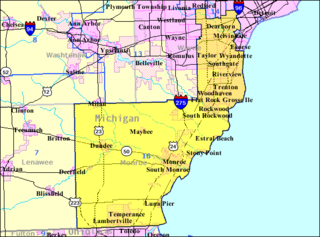List of members representing the district
Indiana admitted December 11, 1816, with one at-large congressional seat.
District inactive since March 4, 1875.
From its statehood in 1816 until 1823, Indiana was allocated only one representative, who was elected at-large. During the 43rd Congress, from 1873 to 1875, Indiana elected three of its thirteen representatives to the United States House of Representatives at-large from the entire state.
Indiana admitted December 11, 1816, with one at-large congressional seat.
District inactive since March 4, 1875.

The 14th United States Congress was a meeting of the legislative branch of the United States federal government, consisting of the United States Senate and the United States House of Representatives. It met in the Old Brick Capitol in Washington, D.C. from March 4, 1815, to March 4, 1817, during the seventh and eighth years of James Madison's presidency. The apportionment of seats in the House of Representatives was based on the 1810 United States census. Both chambers had a Democratic-Republican majority.
The 21st congressional district of Ohio was a congressional district in the state of Ohio. It was eliminated in the redistricting following the 1990 census.
Ohio's at-large congressional district existed from 1803 to 1813, from 1913 to 1915, from 1933 to 1953 and from 1963 until 1967, when it was banned by the Voting Rights Act of 1965.
Ohio's 8th congressional district sits on the west side of Ohio, bordering Indiana. The cities of Hamilton, Fairfield, Middletown, Springfield, Eaton, Greenville, Piqua, and Troy are part of the district. The district was represented by Republican John Boehner, the 53rd Speaker of the United States House of Representatives. On September 25, 2015, Boehner announced his resignation from the speakership and retirement from Congress, which became effective on October 31, 2015.
Pennsylvania's 34th congressional district was one of Pennsylvania's districts of the United States House of Representatives. It covered area north of the city of Pittsburgh, Pennsylvania.
Illinois elected its United States Representative at-Large on a general ticket upon achieving statehood December 3, 1818. It last elected a US Representative in the Election of 1946. The district has been inactive since.
The U.S. state of Pennsylvania elected its United States representatives at-large on a general ticket for the first and third United States Congresses. General ticket representation was prohibited by the 1842 Apportionment Bill and subsequent legislation, most recently in 1967.

Michigan's 16th congressional district is an obsolete United States congressional district in Michigan. It covered the communities of Dearborn, Downriver and Monroe County.
Indiana's 10th congressional district was a congressional district for the United States House of Representatives in Indiana. It encompassed roughly the "Old City Limits" of Indianapolis from 1983–2003. The district was re-drawn after the 1980 census and eliminated when Indiana's representation in the House of Representatives fell from 10 to nine after the 2000 census.

Indiana's 5th congressional district is a congressional district in the U.S. state of Indiana comprising Hamilton, Madison, Delaware, Grant, and Tipton counties, as well as the large majority of Howard County. Much of its population is located in the northern suburbs of Indianapolis, including the cities of Carmel, Noblesville, and Fishers, while other population centers include Muncie, Kokomo, Anderson, and Marion. The district is predominantly white and is the wealthiest congressional district in Indiana, as measured by median income.
Oregon's at-large congressional district is a former United States congressional district. During its existence, Oregon voters elected a Representative of the United States House of Representatives at-large from the entire state.
The state of Colorado was represented in the United States House of Representatives by one member of the House, elected at-large from 1876 until 1893 and from 1903 until 1913, and by two members at-large from 1913 until 1915. Since the 1914 elections, all members from Colorado have been elected from congressional districts.
The U.S. state of Mississippi's at-large congressional district existed from December 10, 1817, when it was admitted to the Union until 1847, when representatives were elected in districts.
Florida's at-large congressional district may refer to a few different occasions when a statewide at-large district was used for elections to the United States House of Representatives from Florida. The district is obsolete.
From December 28, 1846, to March 3, 1847, the new state of Iowa was represented in the United States House of Representatives by two representatives who had been elected on a statewide basis, rather than by districts.
Alabama's at-large congressional district was a congressional district for the United States House of Representatives in Alabama active at various times from 1819 to 1965. Alabama became a state in 1819, and its single representative to the 16th and 17th Congresses was elected at-large. For the 27th Congress, all five of Alabama's representatives were elected at-large, before the state gained a representative from the 1840 census. In the 43rd to 44th Congresses, the seventh and eighth representatives gained in the 1870 census were elected at-large. For the 63rd and 64th Congresses, Alabama elected the tenth of its apportioned representatives, gained in the 1910 census, at-large from the entire state. For the 88th Congress, after the state lost one representative in the 1960 census, Alabama once again elected all of their representatives at-large.
West Virginia gained a sixth seat in the United States House of Representatives after the 1910 census, but failed to adopt a new redistricting plan immediately. In 1912 and 1914, the state elected Howard Sutherland at-large from the entire state, in addition to its five districted representatives.
Alabama's 10th congressional district is an obsolete district which existed from 1917 until 1933. Its sole representative was William B. Bankhead.
Vermont's 2nd congressional district is an obsolete district. It was created upon Vermont's admission as the 14th state in 1791. It was eliminated after the 1930 census. Its last congressman was Ernest W. Gibson, who was redistricted into the at-large district.